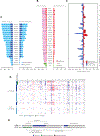Genetic and Epigenetic Determinants of Aggressiveness in Cribriform Carcinoma of the Prostate
- PMID: 30333152
- PMCID: PMC6359952
- DOI: 10.1158/1541-7786.MCR-18-0440
Genetic and Epigenetic Determinants of Aggressiveness in Cribriform Carcinoma of the Prostate
Abstract
Among prostate cancers containing Gleason pattern 4, cribriform morphology is associated with unfavorable clinicopathologic factors, but its genetic features and association with long-term outcomes are incompletely understood. In this study, genetic, transcriptional, and epigenetic features of invasive cribriform carcinoma (ICC) tumors were compared with non-cribriform Gleason 4 (NC4) in The Cancer Genome Atlas (TCGA) cohort. ICC (n = 164) had distinctive molecular features when compared with NC4 (n = 102). These include: (i) increased somatic copy number variations (SCNV), specifically deletions at 6q, 8p and 10q, which encompassed PTEN and MAP3K7 losses and gains at 3q; (ii) increased SPOP mut and ATMmut ; (iii) enrichment for mTORC1 and MYC pathways by gene expression; and (iv) increased methylation of selected genes. In addition, when compared with the metastatic prostate cancer, ICC clustered more closely to metastatic prostate cancer than NC4. Validation in clinical cohorts and genomically annotated murine models confirmed the association with SPOPmut (n = 38) and PTENloss (n = 818). The association of ICC with lethal disease was evaluated in the Health Professionals Follow-up Study (HPFS) and Physicians' Health Study (PHS) prospective prostate cancer cohorts (median follow-up, 13.4 years; n = 818). Patients with ICC were more likely to develop lethal cancer [HR, 1.62; 95% confidence interval (CI), 1.05-2.49], independent from Gleason score (GS). IMPLICATIONS: ICC has a distinct molecular phenotype that resembles metastatic prostate cancer and is associated with progression to lethal disease.
©2018 American Association for Cancer Research.
Conflict of interest statement
Figures



Similar articles
-
Cribriform and intraductal prostate cancer are associated with increased genomic instability and distinct genomic alterations.BMC Cancer. 2018 Jan 2;18(1):8. doi: 10.1186/s12885-017-3976-z. BMC Cancer. 2018. PMID: 29295717 Free PMC article.
-
PTEN loss in prostatic adenocarcinoma correlates with specific adverse histologic features (intraductal carcinoma, cribriform Gleason pattern 4 and stromogenic carcinoma).Prostate. 2019 Aug;79(11):1267-1273. doi: 10.1002/pros.23831. Epub 2019 May 21. Prostate. 2019. PMID: 31111513
-
Detection of chromosomal anomalies and c-myc gene amplification in the cribriform pattern of prostatic intraepithelial neoplasia and carcinoma by fluorescence in situ hybridization.Mod Pathol. 1997 Nov;10(11):1113-9. Mod Pathol. 1997. PMID: 9388062
-
Prostate cancer with cribriform morphology: diagnosis, aggressiveness, molecular pathology and possible relationships with intraductal carcinoma.Expert Rev Anticancer Ther. 2018 Jul;18(7):685-693. doi: 10.1080/14737140.2018.1469406. Epub 2018 Apr 27. Expert Rev Anticancer Ther. 2018. PMID: 29699428 Review.
-
Ductal, intraductal, and cribriform carcinoma of the prostate: Molecular characteristics and clinical management.Urol Oncol. 2024 May;42(5):144-154. doi: 10.1016/j.urolonc.2024.01.037. Epub 2024 Mar 13. Urol Oncol. 2024. PMID: 38485644 Review.
Cited by
-
Cribriform Prostate Cancer: Clinical Pathologic and Molecular Considerations.Urology. 2021 Sep;155:47-54. doi: 10.1016/j.urology.2021.05.028. Epub 2021 May 28. Urology. 2021. PMID: 34058243 Free PMC article. Review.
-
2023 Canadian Urological Association guideline: Genetic testing in prostate cancer.Can Urol Assoc J. 2023 Oct;17(10):314-325. doi: 10.5489/cuaj.8588. Can Urol Assoc J. 2023. PMID: 37851913 Free PMC article. No abstract available.
-
Comedonecrosis Gleason pattern 5 is associated with worse clinical outcome in operated prostate cancer patients.Mod Pathol. 2021 Nov;34(11):2064-2070. doi: 10.1038/s41379-021-00860-4. Epub 2021 Jun 26. Mod Pathol. 2021. PMID: 34175896 Free PMC article.
-
Prognostic Significance of the Cribriform Pattern in Prostate Cancer: Clinical Outcomes and Genomic Alterations.Cancers (Basel). 2024 Mar 22;16(7):1248. doi: 10.3390/cancers16071248. Cancers (Basel). 2024. PMID: 38610926 Free PMC article.
-
AZIN1 RNA editing alters protein interactions, leading to nuclear translocation and worse outcomes in prostate cancer.Exp Mol Med. 2022 Oct;54(10):1713-1726. doi: 10.1038/s12276-022-00845-6. Epub 2022 Oct 6. Exp Mol Med. 2022. PMID: 36202978 Free PMC article.
References
-
- Epstein JI, Egevad L, Amin MB, Delahunt B, Srigley JR, Humphrey PA. The 2014 International Society of Urological Pathology (ISUP) Consensus Conference on Gleason Grading of Prostatic Carcinoma: Definition of Grading Patterns and Proposal for a New Grading System. The American journal of surgical pathology 2016;40:244–52 - PubMed
-
- Gleason DF. Classification of prostatic carcinomas. Cancer chemotherapy reports 1966;50:125–8 - PubMed
-
- Kweldam CF, Wildhagen MF, Steyerberg EW, Bangma CH, van der Kwast TH, van Leenders GJ. Cribriform growth is highly predictive for postoperative metastasis and disease-specific death in Gleason score 7 prostate cancer. Modern pathology : an official journal of the United States and Canadian Academy of Pathology, Inc 2015;28:457–64 - PubMed
Publication types
MeSH terms
Grants and funding
LinkOut - more resources
Full Text Sources
Medical
Molecular Biology Databases
Research Materials
Miscellaneous

